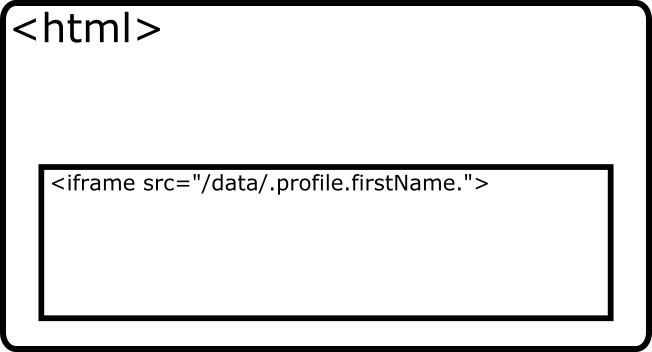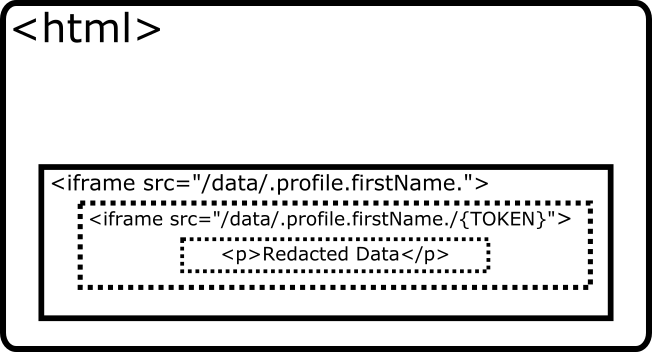Overview
The best way to begin understanding how Redact works is to understand, at a high-level, what the general flow of information is when a user visits a Redact-enabled website. Below is a diagram outlining this flow.

Alice opens her browser and visits a Redact-enabled website (e.g. www.foo.com).
The website’s server responds with the contents of the page, which include
<iframe>elements for instances where the website displays “Redacted” data.Alice’s browser issues a request to the local Client for each iframe, each of which represents a different piece of secured data.
The Client receives each request and forwards them to the Storage.
The Storage instance responds to each request with the data it has stored at that path. These pieces of data are typically encrypted and cannot be decrypted by the Storage instance itself.
The Client decrypts the encrypted data, then responds to the local request from the browser with the decrypted text in a secure iframe. The user can now see the secure data, but the host website cannot.
Secure <iframe>
Although there already exist several end-to-end encrypted applications in use commercially today, none of them quite solve the problem of endpoint security. These services provide strong security both in transit and at rest using their encryption protocols, but there still remains the issue of displaying the actual data to the user: data must be decrypted and placed on the screen at some point, and existing end-to-end encryption applications maintain control over this process. This means there is a point in the data pipeline where the user must trust the operator of the service not to inject malicious code and exfiltrate plaintext data.
Redact solves this issue by limiting the trusted platform to just the
browser, rather than all the websites visited on the browser. The Client
leverages <iframe> elements and CSRF tokens to allow websites to easily
interact with protected data without having to, or in fact being able to,
actually see it at any point. This technique works using
technologies that are well-proven and decades old, and requires no Javascript.
The general flow to request data to be displayed works as such:
The website places an
<iframe>element as a placeholder for the data:<iframe src="/unsecure/data/.profile.firstName."></iframe>
There are additional parameters that can be provided which further customize the Client’s response, but are left out here for simplicity.

The Client receives the request and does four things:
Generates a random 256-bit session token.
Attaches a session to the request.
Stores the token in the session.
Responds to the request with a session cookie containing the ID of the request’s session and an HTML page containing another
<iframe>, attaching the token generated in step 1 to the end of the URL path, like this:<iframe src="/secure/data/.profile.firstName./498DF68A39A51DE648799EE13CD26D2163863FC5F43814B8895B78BBA45935A0"></iframe>

Upon rendering the iframe response, the browser makes another request to the Client, once again according to the
srcof the inner<iframe>. The Client receives the request and attempts to respond with the decrypted data:Retrieves the session based on the session ID provided in the request cookie header.
Compare the token in the URL of the request with the token stored in the session.
If the tokens match, it proceeds with fetching the requested data, decrypting it, and responding with an HTML page containing the plaintext. If the tokens do not match, the request is rejected.

This process allows the Client to ensure that the only time it responds with plaintext data is when the request for the data is coming from itself.
Imagine that a malicious website, acme.com, would like to exfiltrate Alice’s
redacted data when she visits. In order to do so, they place a script on
acme.com that runs when Alice visits the website and makes an AJAX
request to the Alice’s Client for data at the path
.profile.firstName.. This request succeeds and responds with a 200 status
code, but the returned HTML just contains an <iframe> element, this time
with a token appended to the end of the src attribute. The script then makes
a second AJAX request with the token appended at the end this time.
This request will fail. It isn’t enough to provide the correct token at the end of the request path, that request must also be paired with a session that contains the same token. This pairing occurs by attaching the session ID returned by the Client in the first request as a cookie header in the second request. Thanks to all modern browsers’ cross-origin resource sharing (CORS) protections, it is impossible for a website located at acme.com to fetch the session ID set by a website not at the same domain.
Warning
Cookies set by a domain other than the primary domain being visited are classified as “third-party cookies” by browser vendors. Browsers are increasingly placing limitations on these cookies, the latest being that such cookies MUST be transferred over a TLS connection. Currently the connection between browser and Client, both on the user’s local device, is not secured by TLS. In the future, it may be necessary to add a self-signed certificate generated by the Client to the browser in order to secure that connection.